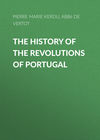Buch lesen: «The History of the Revolutions of Portugal», Seite 13
AN ACCOUNT
OF THE
DIAMONDS OF BRAZIL. 53
Principal Districts wherein Diamonds are found
THE province of Brazil, which produces diamonds, is situated inland, between 22½ and 16 degrees of south latitude. Its circumference is near 670 leagues. On the east it is limited by the captaincy or province of Rio Janeiro; on the south by that of St. Paul; on the north by the Sertoens, or interior part of the maritime province of the Bay of All Saints, and part of that of the mines of Goyarel; on the west, lastly, by another part of the last-mentioned province, and by those deserts and forests which are inhabited by the savages, and extend to the frontiers of Paraguay. On the side nearest St. Paul there are vast uncultivated plains; the interior is divided by chains of mountains and hills, with superb vallies and luxuriant fertile plains. It abounds with wood, and is watered by a great number of rivers and brooks, that facilitate the working of the mines of gold, which is obtained by washing in spangles from the river sands, or in veins open to the day. This province is divided into four comarcas or districts, which, reckoning from north to south, are, Santo Joao del Rei, Villa-Rica, Sabara, and Sero-Dosrio, or Cold Mountain, called in the language of the savages Yritauray. The diamonds are found in this last district. The whole province is very rich in the ores of iron, antimony, zinc, tin, silver, and gold.
There are also diamond mines in the other districts of Brazil; particularly in Cuiaba, in the country of Guara-Puara, and in the government of St. Paul; but these mines have never yet been explored.54
Discovery of the Mines
The Paulists and inhabitants of the ancient captaincy of St. Vincent were the first who discovered these mines, and peopled, in great part, the whole of this rich province, as well as those of Matto-Grosso, Cuiahe, Goyares, and Rio Grande de San Pedro. Anthonio Soary, a Paulist, who gave his name to one of these mountains, was the first who discovered and visited the Sero-Dosrio. Gold only was sought for, but at last diamonds were discovered in the Riacho Fundo, whence they were first obtained, and afterwards in the Rio de Peire; a great number were likewise obtained from the Giguitignogna, a very rich stream; and, lastly, in the end of 1780, and beginning of 1781, a gang of nearly three thousand interlopers, called Grimpeiros, discovered diamonds, and obtained an immense quantity from the Terra de Santo Antonio; but they were forced to abandon this spot to the royal farm, who took possession of it. Then it was that the suspicion was confirmed, that the mountains are the true matrices of diamonds; but as the work in the beds of rivers and on their banks is less tedious, can be conducted on a larger scale, and affords larger diamonds, the farm abandoned the mountains, and formed great establishments in the river of Toucanbirnen, which flows through the valleys of this chain, and is near ninety leagues in length. It was found by examination and digging, that the whole surface of the ground, immediately beneath the vegetable stratum, contained more or less of diamonds, disseminated and attached to a matrix ferruginous and compact in various degrees, but never in veins, or in the division of geodes.
Figure of the Diamonds, and manner of exploring them
The figure of the diamonds of Brazil varies. Some are octoedrical, formed by the union of two tetraedrical pyramids. This is the Adamas octoëdrus turbinatus of Wallerius, or the octoedrical diamond of Romé de l’Isle. These are almost always found in the crust of the mountains; others are nearly round, whether by a peculiar crystallization or by rolling. They resemble those Oriental stones, which the Portugueze and natives of India call reboludos, which signifies rolled. Lastly, others are oblong, and appear to me to be the Adamas hexaëdrus tabellatus of Wallerius. The two last are usually found in the beds of rivers and broken places in their banks.
Diamonds are also found, as I have remarked, in the crust or external covering of mountains. These masses are formed of a bed of ferruginous sand, with rolled flints, forming an ochreous pudding-stone, from the decomposition of emery and muddy iron-ore; it is called cascalho, and the beds, or strata, taboleiros. These taboleiros have different names, according to their situation or their nature. When the stratum is horizontal, and in the plane of the bed of the river, it is properly called a taboleiro; but if it rises in banks, it is called gopiara: lastly, if the pudding-stone contains much emery, it is then denominated tabanhua cauga in Brazilian, that is to say, black-stone or iron-stone.
In some places the cascalho is uncovered, in others, it lies beneath a kind of vegetable muddy earth, humus damascena, Linn, or beneath a reddish fat sand, which sometimes contains roundish flints. This happens in the returns of the mountains, or upon the banks of great torrents. This sand is called pisarra. The bank, or stratum beneath the cascalho, is either shistus, rather sandy, or the solid bog-ore of iron. It is likewise in the cascalho that gold in spangles and in pyrites is found; the former of which is, in my opinion, afforded by the decomposition of the auriferous pyrites; for the gold in veins has another form, and its matrix is either fat quartz, or fine grained tender cos, micaceous gneis, or the quartzose ore of iron, tophus ferreus. Linn.
The exploring of diamonds is performed by changing the beds of streams, in order that the sand or gravel may be washed, and the diamonds selected; or by breaking the cascalho with large hammers, and afterwards washing it in troughs. This washing differs from that of gold, because it requires a small quantity of very clear water, and very little of the cascalho at a time; proportions, which are precisely contrary to those required in washing gold. Black slaves are employed in this business, entirely naked, excepting a cloth round their middle, in order that they may not embezzle any of the diamonds; but in spite of every precaution, and the vigilance of numerous inspectors, they nevertheless find means of concealing them, which they sell at a very low price, to the interlopers, for tobacco and rum.
An estimate of the Sums produced to the Portugueze Government from the Brazil Diamonds
The diamond mines in Brazil, have at different times brought in different sums to the Portugueze government. Towards the middle of the last century such great quantities of the Brazil diamonds came to Europe; that the value of diamonds of every description was so much decreased, that the London jewellers refused to buy them at any price. The author of the Treatise on Diamonds seems to doubt the existence of the diamond mines in Brazil, and to believe that the great profusion of those stones sold by the Portugueze in the different markets of Europe, were not the produce of their American, but Asiatic colonies. It will be easy to judge of the amount of the profit arising to the Portugueze government, during several years, from the sale of these diamonds, by the following statement. At the epoch of the dreadful earthquake in Lisbon; some English merchants had a contract with those Portugueze who had the direct management of the diamond mines in Brazil, to pay them 120,000l. sterling. The principal conditions of the above contract (according to the account given me by an English gentleman who signed it) were as follows: – the Portugueze directors engaged to secure to the English merchants the exclusive sale of the Brazil diamonds; the latter engaged on their part to take 40,000 carats of rough diamonds, for which they were to pay at the rate of 3l. a carat; making the sum total of 120,000l. sterling. An agreement was also made relative to the purchase and choice of the diamonds. On the cases which contained them being brought from Brazil, they were not to be opened but in presence of the English merchants, which being done, the diamonds were spread on a large table; and a person skilled in precious stones being appointed by the said merchants, he made choice of the most valuable diamonds, excepting those above twenty carats (very few in number), which were reserved for the crown of Portugal. The original contractors being succeeded by others, the price was reduced to 2l. 1s. 8d. sterling a carat; but for some time past this branch of trade has been taken out of the hands of the English, and is in the exclusive possession of the king. The exact sum resulting from this new arrangement is not known, but we have reason to believe it amounts on an average to about 60,000l. sterling, annully.
An Estimate of the Value of Brazil Diamonds, &c
The white diamonds of Brazil when they weigh only from four to five carats, are of equal value with the Oriental ones of the same weight; but when of a larger size, the latter are much more esteemed, on account of the fineness of the water.
The Brazil topaz is esteemed the most valuable next to the Oriental one: it is of a fine yellow, with an orange tint, and takes a very good polish. This topaz, weighing only one carat, is valued, if perfect, at six French livres (5s.), and encreases in value according to its weight, which is determined by the following calculation, as made for the Oriental topaz. Mr. Dutens esteems the Oriental topaz, when perfect, at sixteen French livres (13s. 4d.) the first carat. To know the value of one weighing three or four carats, it is requisite to multiply the one by the other, and to multiply the product by 16; the same rules to be observed for topazes of a greater weight; so that an Oriental and perfect topaz, valued at sixteen livres (13s. 4d.) the first carat, weighing sixteen grains, or four carats, would be worth two hundred and fifty-six French livres (10l. 13s. 4d.), whilst a Brazil topaz weighing likewise four carats, would be only worth ninety-six French livres55 (4l.). There is also another sort of topaz in Brazil, of a very particular nature: it is of a very variable and extraordinary hue, and, being put into a small crucible, filled with ashes, on a slow fire, and taken off when the crucible becomes red, loses its yellow orange colour, and changes to that of the real Balas ruby, the tinge of which is generally beautiful. This topaz is frequently of a dark, smoky, dirty yellow, and was very little esteemed till a jeweller by chance discovered the abovementioned process, which was kept a profound secret, till Mr. Dumelle, goldsmith and working jeweller, disclosed it to the Academy of Sciences of Paris, by the means of Mr. Guettard.56 Many people are of opinion, that the rubies at present brought from Brazil are merely topazes, which have undergone the said operation. The fine crystallization of the Oriental ruby is octoedrical equally with the diamond. That of Brazil crystallizes in prismes, of unequal planes, terminating in pyramids, there are likewise other rubies of a rounder form, owing to their having been rolled in the water. This stone is supposed to take its red colour from iron. The most esteemed rubies come from the island of Ceylon, and are thought more valuable than even those from Pegu. The rubacelle, or small ruby, very common in Brazil, is of a pale red, with a yellow cast; and is the cheapest and least esteemed of any stones of that description; they, however, take a very good polish; and the most perfect amongst them are sometimes passed off for Balas rubies. This last stone may be estimated at thirty French livres (1l. 5s.) one carat; those of two carats at sixty French livres (2l. 10s.), those of three carats at ninety livres (3l. 15s.), and those of four carats at one hundred and twenty livres (5l.), &c.
The mines of Brazil also produce emeralds, which are striated, and terminate in an obtuse pyramid. They are found in oblong prismes of 6, 8, 9, 10, and 12 unequal planes; they are of a dark green colour, with a brownish tinge, and of a very fine water. A fine emerald, weighing a carat and a half, may be estimated at 5l. sterling: those of two carats at 10l. sterling; but over and above this weight, the value of the emerald does not augment in proportion to its size, and even those of the largest kind, if perfect, are still subject to an arbitrary valuation.
Brazil produces two sorts of chrysolites; the one nearly resembles in colour the stone called by the French jewellers Oriental Peridot,57 except that it is a little darker, and mixed with yellow; this chrysolite being not so hard as the peridot, the polish is not quite so brilliant. The other Brazil chrysolite is straw coloured, with a tinge of beautiful green, producing a very fine effect: it is extremely hard, and takes an excellent polish. These chrysolites, when of an apple green, or straw colour with a greenish hue, may be estimated at 1l. sterling the carat: 2l. sterling those of two carats; 3l. sterling those of three carats; and so on, always at the rate of 1l. the carat.
NOTE
Since this Work has been in the Press, Mr. Grant’s History of Brazil has been published; and I have much pleasure in remarking, that his account of the Civil Government, and situation of the Country, is frequently drawn from the same sources as my own. I flatter myself this truly estimable author will pardon my taking notice of an error which has crept into his Work relative to Villegagnon, whom he mentions in the 42d page of his History as having retired (after his return from Brazil) into a monastery of his own order, and spent the remainder of his life in writing against the protestants.58 The fact is, that there were never any monasteries for men in the order of Malta, and that Villegagnon, soon after he came back from his expedition, was named ambassador from his order to Paris, which post he occupied from 1568 to 1570, when he quitted his embassy on account of ill-health, and died on the 9th of February (and not in the month of December, as said by Léry), 1571, at his commandery of Beauvais.













